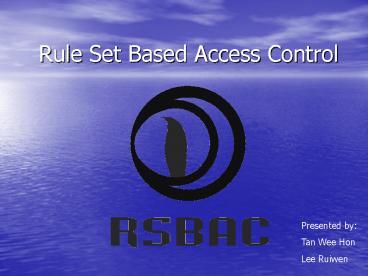Rule Set Based Access Control - PowerPoint PPT Presentation
1 / 24
Title:
Rule Set Based Access Control
Description:
Insecurity of LINUX/UNIX access control. Crude granularity - drwxrwxrwx. Discretionary control ... grant or deny. ADF: Makes decisions. Security Officer (secoff) ... – PowerPoint PPT presentation
Number of Views:67
Avg rating:3.0/5.0
Title: Rule Set Based Access Control
1
Rule Set Based Access Control
Presented by Tan Wee Hon Lee Ruiwen
2
Presentation Outline
- Introduction
- Framework
- Implemented Models Demo
- Application
- Advantages
- Resources References
3
Introduction
- History
- Why RSBAC?
- Goals
4
History of RSBAC
- Amon Ott
- Nov 1996 Master thesis
- Jan 1998 First public release
- Current stable version 1.2.2
5
Why RSBAC?
- Insecurity of LINUX/UNIX access control
- Crude granularity - drwxrwxrwx
- Discretionary control
- Super user root
6
Goals of RSBAC
- Secure access control
- Flexible choice of models
- Combination of models
- Portability
7
Framework
- Subjects, Objects and Requests
- Architecture
- Security Officer
8
Subjects, Objects Requests
- Subjects
- Processes
- Objects (Targets)
- e.g. FILE, DIR, USER, PROCESS
- Requests
- What a subject wants to do with an object
- e.g. CHANGE_OWNER, DELETE, READ_OPEN, MOUNT
9
Components
- ACI Access Control Information
- AEF Access control Enforcement Facility
- ADF Access control Decision Facility
10
Components
- ACI Stores status data and configuration items
- AEF Intercepts Linux kernel calls
- ? grant or deny
- ADF Makes decisions
11
(No Transcript)
12
Security Officer (secoff)
- Configure modules using utilities provided in the
RSBAC distribution - Difference between root and secoff is effort to
obtain rights to access anything
13
Implemented Models
- Authentication (AUTH)
- Functional Control (FC)
- Security Information Modification (SIM)
- Privacy Model by Simone Fischer-Hübner (PM)
- Malware Scan (MS)
- Linux Capabilities (CAP)
- Mandatory Access Control (MAC)
- File Flags (FF)
- Role Compatibility (RC)
- Access Control Lists (ACL)
14
Implemented Models
- Authentication (AUTH)
- Functional Control (FC)
- Security Information Modification (SIM)
- Privacy Model by Simone Fischer-Hübner (PM)
- Malware Scan (MS)
- Linux Capabilities (CAP)
- Mandatory Access Control (MAC)
- File Flags (FF)
- Role Compatibility (RC)
- Access Control Lists (ACL)
15
Mandatory Access Control (MAC)
- Bell-La Padula
- 253 security levels
- 64 categories (bit vector)
- For programs not MAC aware, current security
levels and categories are automatically adjusted
as necessary, but within read and write level
boundaries
16
File Flags (FF)
- Conveniently assign rights to whole directory
trees - Inheritable FILE, DIR, FIFO and SYMLINK
attributes - e.g. read-only, no-execute, secure-delete
17
Role Compatibility (RC)
- Roles and types
- Role can access type only if compatible
- Forced and Initial Roles based on program files
- Separation of Administration Duties
- Separate sets of roles e.g.
- Admin Roles
- Assign Roles
- Additional access rights for types Admin,
Assign, Access Control, Supervisor
18
Access Control Lists (ACL)
- What subject may access which object with which
requests - Subjects RC roles, Users, ACL Groups
- ACL Groups
- All users can have individual groups
- Private and global groups
- Inheritance with masks
- Special Rights e.g. supervisor
19
Application
- Workstations
- Server systems
- Examples
20
Workstations
- Protection against unwanted configuration changes
- Malicious software (malware) protection
- Reduced administration work
21
Server Systems
- Encapsulation of services
- Need-to-Know principle
- Malware protection
- Firewalls DNS, Proxies
- (Virtual) Webservers Apache
- (Virtual) mail servers POP3, IMAP
- File servers Samba
- Application servers
22
Examples
- Compuniverse Firewalls
- More than one year with RSBAC
- Use of AUTH, FF and RC models
- Software selection for better RSBAC control, e.g.
POP3 with separate authentication program
23
Advantages
- Provides well-known and new models
- Extensible
- Flexible
- Powerful logging system
- Support for current Linux kernels, ports to
others systems likely - Increasing downloads and feedback
24
Resources References
- Homepage www.rsbac.org
- The RSBAC Library
- An Introduction
- Programmers Reference Manual
- Programmers Cookbook
- Reference Manual
- Cookbook
- Detailed paper
- Ott, Amon (2001). The Rule Set Based Access
Control (RSBAC) Linux Kernel Security Extension.
(International Linux Kongress, 2001)































